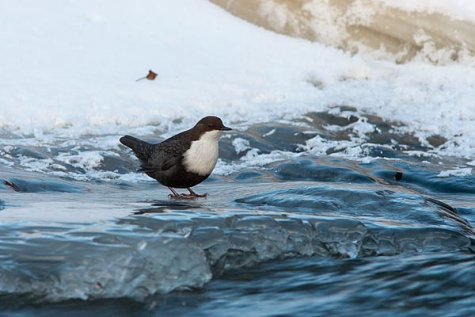In severe cold in the river rapids
Photo: Kaarel Kaisel
Translation: Liis
Dipper
| Dipper |
Vesipapp |
About one or two hundred of the dippers that arrived in Estonia in autumn from the north stayed to winter here. We can meet “the river cantor“ - as people called the dipper in old times – in running waters with rapid cascade flow. The white throat and breast patch and the black plumage, brown on the belly, convey an impression of the dress of a man of the church, and some of the bird’s movements underline it – when the dipper is excited it makes quick bows that also demonstrate how short its tail is.
The winter day is spent in searching for food in ice-free rapids. The dipper walks into the water, or dives from a broken branch, a stone or the verge of the ice bank, if necessary diving to a depth of a metre. What does it look for? Fish fry up to 5 cm long, but mostly water lice (Asellus), gammarids, caddisfly larvae and molluscs. With its beak it turns or shifts small stones on the river bottom where insects may hide – the dipper knows. The nights it spends in hollows in the river bank, preferably such that only are accessible through water – hidden and thus secure.
Very rarely there may be more than one dipper in some rapids in winter. Its quiet song isn’t heard until in March, when the pairs meet. In the wintering areas water clarity is important, making it is easier to catch the prey. With the coming of the waters from melting snow they set out on their migration to the breeding areas.









